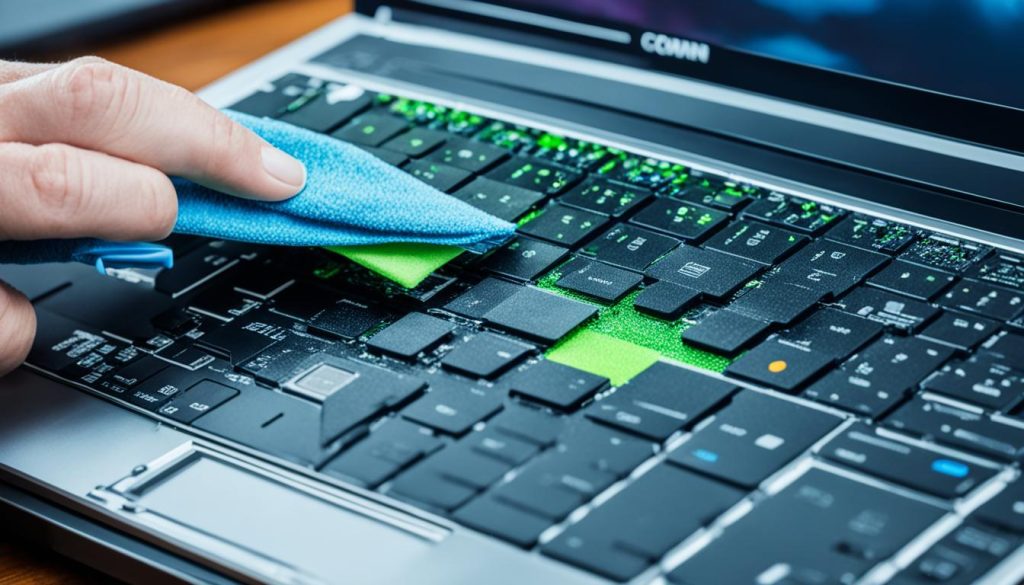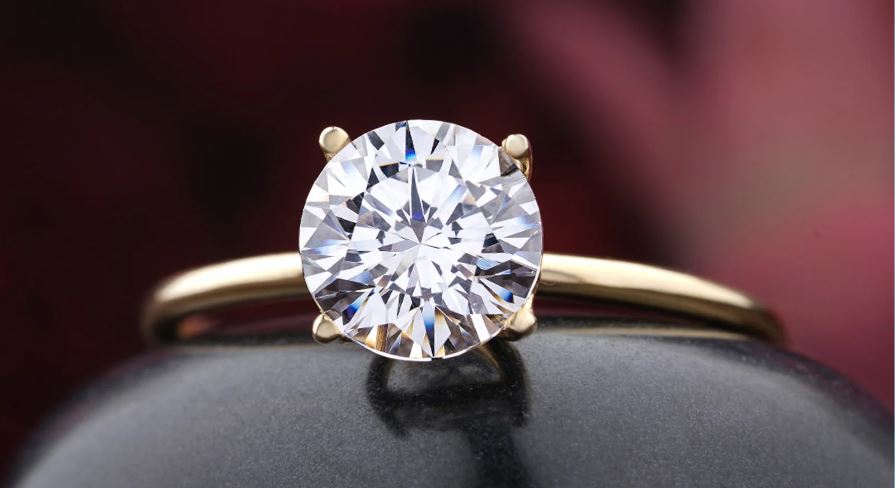Cleaning your laptop is essential to maintain its appearance and functionality. This comprehensive guide will walk you through the step-by-step process of how to clean a laptop and disinfecting all aspects of your laptop, including the screen, keyboard, outside surfaces, vents, and ports. By following these tips, you can ensure that your laptop stays clean and in top condition.
Gathering the Cleaning Supplies
Before you begin cleaning your laptop, make sure you have the necessary supplies. It’s important to have the right laptop cleaning products and tools to effectively remove dirt, dust, and grime from your device. Here are the essential items you’ll need:
| Laptop Cleaning Products | Laptop Cleaning Tools |
|---|---|
|
|
The microfiber cloth is the most effective tool for cleaning your laptop. Unlike cotton rags or paper towels, it won’t leave lint or scratch delicate surfaces. Tap water or distilled water, along with a small amount of dish soap, can be used as a safe cleaning solution for most laptop components. Alternatively, you can use vinegar mixed with water for tougher stains. Isopropyl alcohol and hydrogen peroxide are great for disinfecting surfaces. However, be sure to avoid using ammonia and bleach-based products, as they can be harsh on your laptop’s surfaces.
In addition to cleaning products, you’ll also need a few laptop cleaning tools to ensure thorough cleaning. A can of pressurized canned air is essential for removing dust and debris from hard-to-reach spaces like keyboard crevices and cooling vents. Plastic dental cleaners with tiny bristles can help dislodge stubborn debris and reach tight spaces.
With the right laptop cleaning products and tools on hand, you’re well-equipped to give your laptop a thorough cleaning. In the next section, we’ll walk you through the steps to prepare your laptop for cleaning.
How to Clean a Laptop Thoroughly?
Before you embark on your laptop cleaning routine, it’s crucial to take a few necessary precautions to ensure the best way to clean a laptop without causing any damage. Follow these steps to prepare your laptop for a thorough cleaning:
Gather Your Cleaning Supplies
Before starting the cleaning process, gather all the essential laptop cleaning products:
- Microfiber cloth
- Pressurized canned air
- Plastic dental cleaners with tiny bristles
- Distilled water
- Dish soap
- Vinegar
- Isopropyl alcohol
- Hydrogen peroxide
Avoid using ammonia and bleach-based products, as they can be harsh on your laptop’s surfaces.
Preparation Steps
- Turn off your laptop and unplug it from the power source. This prevents accidental key presses and protects your laptop from damage.
- Clean your hands thoroughly with soap and water before and after cleaning to prevent transferring dirt and oils to the laptop. If you have sensitive skin, consider wearing gloves while using cleaning products.
- Choose a well-ventilated area to clean your laptop to avoid inhaling any fumes. Opening windows or turning on a fan can help improve ventilation.
- Place your laptop on a clean towel or a soft, flat surface to protect it from scratches during the cleaning process.
By following these steps, you’ll ensure that you’re taking the necessary precautions before embarking on your laptop cleaning routine. Now, let’s move on to the next section for detailed instructions on how to effectively clean the various components of your laptop.
| Cleaning Supplies | Description |
|---|---|
| Microfiber cloth | Avoid scratches and streaks on your laptop’s surfaces |
| Pressurized canned air | Remove dust and debris from hard-to-reach areas |
| Plastic dental cleaners | Dislodge stubborn debris in tight spaces |
| Distilled water | Safe and effective for cleaning laptop surfaces |
| Dish soap | Dissolve stains and grime on keyboards and touchpads |
| Vinegar | Mildly acidic for removing tough stains |
| Isopropyl alcohol | Disinfect and clean surfaces |
| Hydrogen peroxide | Kills bacteria and removes stains |

When it comes to cleaning your laptop, proper preparation is key. By following the steps outlined above and using the best laptop cleaning products, you’ll be ready to tackle the task ahead.
Clearing Dust and Debris
Keeping your laptop free from dust and debris is essential for its optimal performance. Dust can accumulate in various areas, including the keyboard, screen edges, touchpad buttons, physical ports, and cooling vents. Here are some laptop cleaning techniques to help you effectively clear away dust and debris:
- Start by using a can of pressurized air, directing short bursts to blow away visible dust and debris. Keep the nozzle at a safe distance to prevent condensation and moisture from forming on the laptop’s surfaces.
- If you encounter stubborn debris that is difficult to remove with the canned air, consider using dental cleaners with tiny bristles. Gently loosen and dislodge the debris without applying too much force, as aggressive cleaning may cause damage.
Remember, when using the canned air and dental cleaners, always exercise caution and avoid putting excessive pressure on the laptop.
Expert Tip: Regularly cleaning your laptop’s cooling vents is crucial to prevent overheating. Clogged vents can hinder proper airflow, leading to performance issues and potential damage to internal components. Pay special attention to these areas during your laptop cleaning routine.
By regularly clearing dust and debris from your laptop, you can maintain its longevity and ensure smooth operation.

| Benefits of Clearing Dust and Debris | Consequences of Neglecting Cleaning |
|---|---|
|
|
Cleaning the Keyboard and Touchpad
To keep your laptop in optimal condition, it’s important to regularly clean the keyboard and touchpad. These areas can accumulate dirt, debris, and even bacteria over time. Follow these laptop maintenance tips to ensure your keyboard and touchpad remain spotless and functional.
Start by using a microfiber cloth dampened with a cleaning solution. Begin at the bottom row of keys and work your way up, using gentle circular motions to remove any dirt or grime. Be careful not to apply too much pressure or use excessive liquid that can seep into the laptop.
If there are stubborn stains on the laptop keyboard, a tiny amount of diluted dish soap can be used to break them down. However, it’s important to avoid spraying any liquid directly on the keyboard to prevent damage.
“A clean keyboard promotes efficient typing and prevents the buildup of dirt and debris.”
After cleaning, use a dry microfiber cloth to polish the surfaces and remove any streaks. This will leave your keyboard looking pristine and ensure a smooth typing experience.
Similarly, the touchpad should also be cleaned using a microfiber cloth and cleaning solution. Wipe the touchpad in gentle circular motions to remove any dirt or smudges. Remember to avoid applying excessive pressure or using excessive liquid. After cleaning, use a dry cloth to remove any remaining moisture.
Regularly cleaning your laptop’s keyboard and touchpad as part of your laptop cleaning routine will not only keep them looking great, but will also help prevent the spread of germs and ensure smooth functionality.
Cleaning the Screen and Exterior Surfaces
When it comes to maintaining your laptop’s crisp display and gleaming exterior, using the right cleaning techniques and products is essential. By following these simple steps, you can keep your laptop looking its best and ensure optimal performance.
Start by gathering your cleaning supplies. You’ll need a microfiber cloth and a suitable cleaning solution. Avoid spraying the solution directly onto the screen or the laptop’s surfaces to prevent moisture from entering the device. Instead, dampen the microfiber cloth with the cleaning solution.

Gently wipe the laptop screen using a circular motion to remove dirt and stains. Take care not to press too hard, as excessive pressure can damage the screen. For stubborn stains, you can use a small amount of rubbing alcohol on the microfiber cloth, but always test it on a small, inconspicuous area first.
Next, clean the exterior surfaces of your laptop. This includes the palm rest, touchpad, lid, and underside. Use the same cleaning method as you did for the screen, using gentle circular motions. Remember to be cautious and avoid applying too much pressure.
Regularly cleaning the screen and exterior surfaces of your laptop not only enhances its appearance but also removes dirt and debris that can affect its performance. By incorporating these laptop cleaning techniques into your maintenance routine, you can keep your device in top shape for years to come.
Conclusion
Regularly cleaning your laptop is essential to keep it in top condition and prolong its lifespan. By following the steps outlined in this guide and using the appropriate cleaning supplies, you can ensure that your laptop remains spotless and functioning optimally. Remember to clean your laptop’s screen, keyboard, exterior surfaces, and vents regularly to prevent the buildup of dust, dirt, and germs. With proper maintenance, your laptop will look brand-new and continue to perform at its best.
FAQ
Why is it important to clean a laptop regularly?
Regularly cleaning your laptop is essential to maintain its appearance and functionality. Dust, dirt, and debris can accumulate over time, leading to poor performance and potential hardware issues. Cleaning your laptop helps prevent overheating, extends its lifespan, and ensures optimal performance.
What supplies do I need to clean my laptop?
To clean your laptop, you will need a microfiber cloth, pressurized canned air, plastic dental cleaners, distilled water, dish soap, vinegar, isopropyl alcohol, and hydrogen peroxide. These supplies will effectively remove dirt, stains, and germs without damaging your laptop.
How should I prepare my laptop for cleaning?
Before you start cleaning your laptop, turn it off and unplug it. Clean your hands thoroughly to avoid transferring dirt and oils to the laptop. If you have sensitive skin, consider wearing gloves. Choose a well-ventilated area and place your laptop on a clean towel on a flat surface to protect it from scratches.
How do I clear dust and debris from my laptop?
Use a can of pressurized canned air to blow away dust and debris from the keyboard, screen edges, touchpad buttons, physical ports, and cooling vents. Use short bursts of air, keeping the nozzle at a distance to prevent condensation. For stubborn debris, gently dislodge it with plastic dental cleaners.
How do I clean the keyboard and touchpad?
Dampen a microfiber cloth with a cleaning solution and start at the bottom row of keys. Use circular motions to remove dirt and grime. Avoid applying too much pressure or excessive liquid. Do not spray liquid directly on the keyboard. For stubborn stains, use a tiny amount of diluted dish soap. After cleaning, use a dry microfiber cloth to polish the surfaces.
How do I clean the screen and exterior surfaces of my laptop?
Gently wipe the laptop screen and exterior surfaces with a microfiber cloth dampened with a suitable cleaning solution. Avoid spraying the cleaning solution directly onto the screen. For stubborn stains on the screen, consider using a small amount of rubbing alcohol. Clean the rest of the exterior surfaces using the same cleaning method.
How often should I clean my laptop?
It is recommended to clean your laptop once every 1-3 months, depending on usage. If you use your laptop in a dusty or dirty environment, clean it more frequently. Regular cleaning will help maintain its appearance, functionality, and performance.
Can I use ammonia or bleach-based products to clean my laptop?
No, it is important to avoid using ammonia or bleach-based cleaning products on your laptop. These products can be harsh on the laptop’s surfaces and may cause damage. Stick to the recommended cleaning solutions mentioned in this guide, such as distilled water, dish soap, vinegar, isopropyl alcohol, and hydrogen peroxide.






